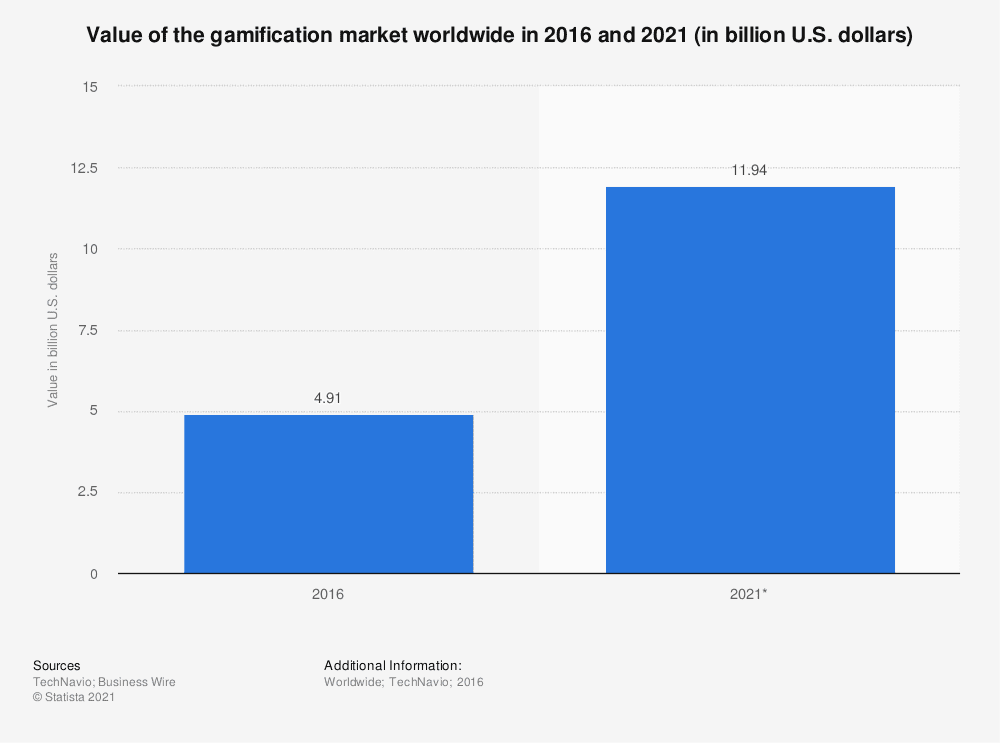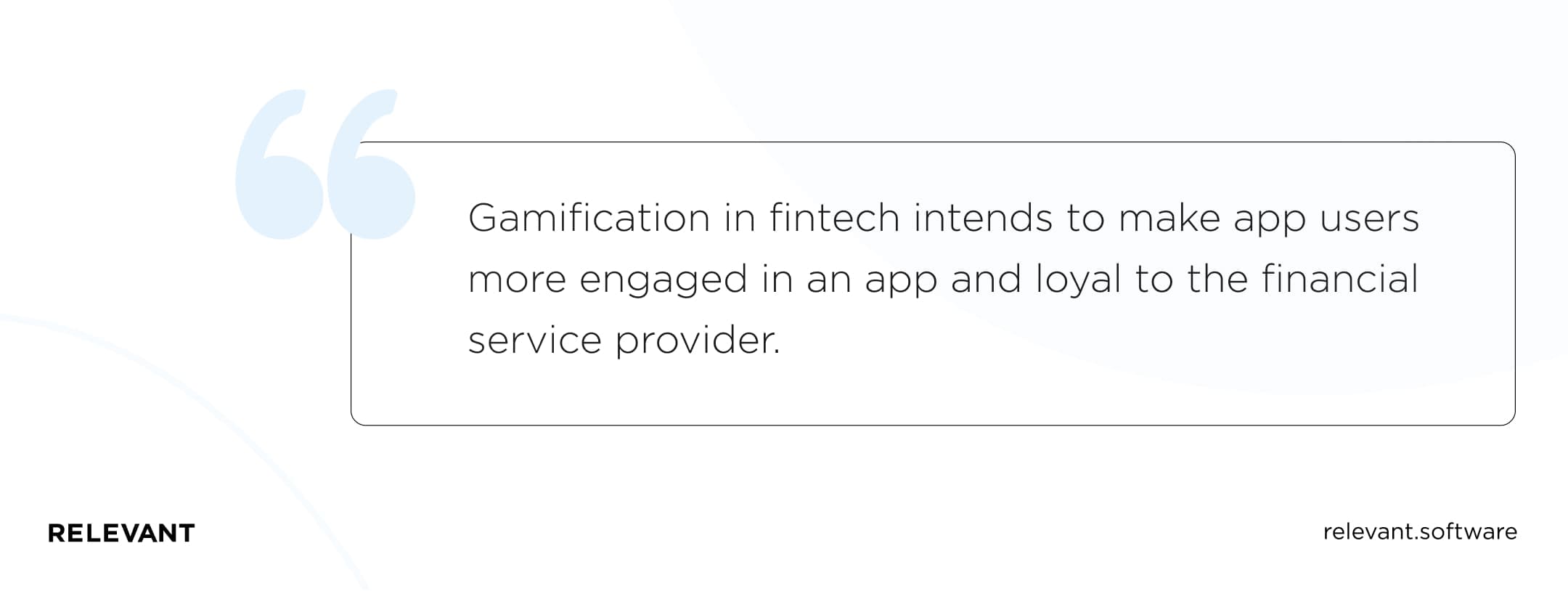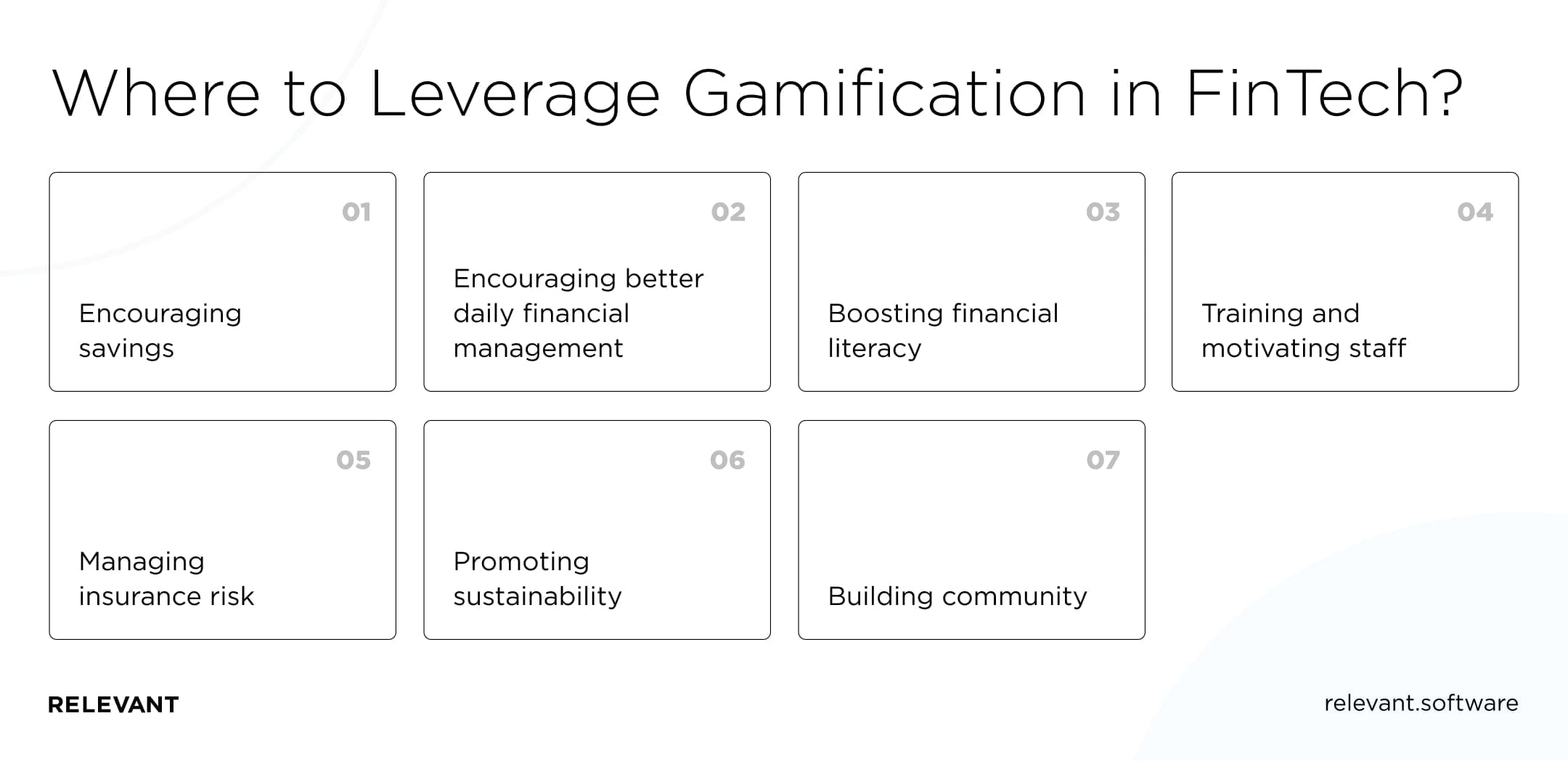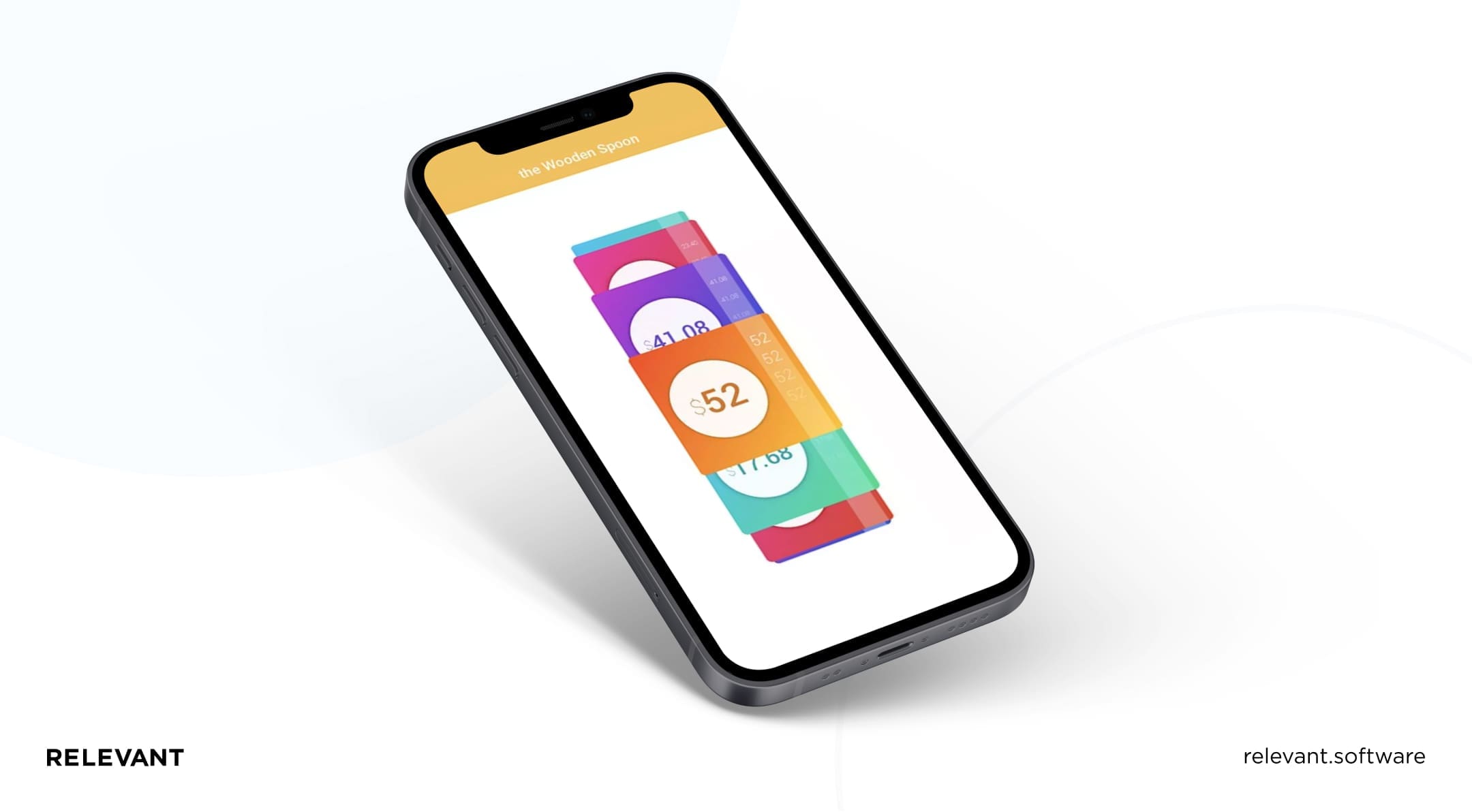Gamification in Fintech: Examples and Best Practices
Updated: August 15, 2024
It’s difficult to make financial services engaging since it’s all about tables, charts, and numbers. Still, businesses in all sectors try to increase customer engagement through digital offerings, and fintech is no exception. Adding gamification to fintech solutions is one of the ways to meet the challenge. Game-like elements help financial businesses engage users more effectively and turn routine tasks into fun and rewarding activities.
At Relevant, we know what that means. As an app development company, we build gamified software for financial services that is both efficient and fun.

We provide companies with senior tech talent and product development expertise to build world-class software. Let's talk about how we can help you.
Contact usIn this post, we’ll look at fintech gamification in detail and share our expertise in this sector. We’ll also review the strategies top fintech players employ to create products that users keep coming back to.
Table of Contents
Gamification explained
What is gamification anyway? Simply put, gamification means adding game mechanics, elements, and experiences to a non-game product to make it more appealing, engaging, and fun.
Gamification helps attract users to an app and keeps them engaged in it for longer. That’s a huge benefit if you want to make your financial service more appealing or shape user behavior. So how big is the gamification market now? The short answer is: very.
The value of the gamification market has more than doubled over the past five years, as more and more businesses turn to gamifying aspects of their apps. According to Statista, gamification investment skyrocketed from $4.91 billion in 2016 to $11.94 billion in 2021.

Gamification is growing equally fast in fintech, including the insurance, bank, stocks, or personal finance niche. Some companies are even exploring the potential of the gamification of investing, and the combination of gamification and blockchain technology.
Overall, gamification in fintech intends to make app users more engaged in an app and loyal to the financial service provider. It helps breathe life into products that would be plain boring otherwise; in other words, it aims to turn a financial or business app experience from a chore on a to-do list into a pleasant activity.

On the other hand, an app overloaded with gaming mechanics can make a financial product look unreliable and suspicious. The challenge is for companies to find the golden ratio of gamification that livens up an app while still keeping it all about serious business.
Here are some examples of companies and services that have got that balance right:
- Monobank is an online bank in Ukraine that offers a gamified app. The app comes with a cute cat emoji and fun game mechanics. For instance, you need to shake your phone to activate a peer-to-peer money transfer.
- Smarty Pig is a free online piggy bank that helps users save up for financial goals such as vacations, holiday gifts, and even retirement. In this app, users can set their financial goals, automatically transfer money from their bank account to their chosen goal, and see the progress bar. Gamification makes saving a fun activity.
- PayPerks is a web-based financial services company that built an educational SaaS platform. The platform helps low and moderate-income users improve their financial knowledge and well-being through visual educational aids, gamification, and sweepstakes-based rewards.
It all comes down to this: successful fintech businesses implement gamification patterns and come up with easy gamification ideas to deliver a delightful user experience.
Typical domains to implement gamification
So what’s the secret sauce for gamifying serious and somewhat grumpy banking apps? The answer is: using the right gamification design and mechanics in the right places.
Here are some areas where top runners in the industry are leveraging gamification today:
- Encouraging savings. Savings are one of the easiest things to gamify. You can allow users to set savings goals and reward users for reaching them, or provide an option for rounding up or capping every transaction and sending the difference to a savings account.
- Encouraging better daily financial management. Apps with financial limits and goals help users establish personal financial plans, track their spending, and stick to a budget.
- Boosting financial literacy. Easy-to-implement gamification ideas include games and short videos that explain complex financial concepts in a fun and engaging way.
- Training and motivating staff. Real-life simulators with gamified design and mechanics can make learning more meaningful. Compared to traditional learning courses, they help users learn faster with less effort.
- Managing insurance risk. Gamification features can be used to shape user behavior. Scores, bonuses, and other fun features help users follow insurance contract terms better.
- Promoting sustainability. Businesses that aim to present themselves as more sustainable and ethical can do this with the help of gamification: for example, by giving a donation to charity when a user meets a certain goal or completes a certain action.
- Building community. Gamified software can help create a community feeling and unite people who are users of the same financial service. For example, users can be rewarded for recommending a bank to a friend.
In essence, gamification in fintech is mainly used to explain complex topics to regular users in simple words, encourage users to change their behavior, and stick to that behavior. Gamification can also help you collect more personal data about your users so you can customize your services and offer a more personal approach.
Relevant is ready to develop any of the above gamification strategies for you. If you’re looking for ways to digitalize your business or update your offering, now could be a perfect time to invest in gamification.

Basic gamification principles
No matter where gamification is used, good implementation follows a few basic principles:
- Goals need to be reachable with reasonable effort. If they are too easy, users get bored; if they’re too hard, users get frustrated.
- Rules need to be fair for every user and clear. They should motivate, not discourage.
- Challenges need to correspond to the goals users reach when overcoming them.
- Feedback needs to be positive and constant. It should empower users to work harder on reaching the app milestones and goals.
Basic game elements include points, badges, and leaderboards. But businesses can implement the above principles in many different ways. Keep on reading to learn how we did it for our fintech clients.
Gamifying solutions from Relevant
At Relevant, we have experience in fintech application development. Our team provides companies with senior tech talent and product development expertise to build world-class software. Whether you’re looking for SaaS application development or wondering how to build a personal finance app, we’re here to help.
But don’t just take our word for it. Here are three fintech case studies we’re proud of.
Kaizo: Making customer support a game
Kaizo is a cloud-based SaaS platform for boosting the operational efficiency of support teams. With the help of AI, it gamifies and simplifies routine work processes. Within the platform, Dojo Master is an upgraded gamified solution for boosting employee motivation, setting targets, and training skills.
We created Kaizo with gamification features such as a dashboard for agents to track their stats and achievements, receive goals, improve skills, and level up avatars; a KPI lab; and an incentive store (a market where managers can exchange their points for merchandise).
The Kaizo app was launched with a 5/5 rating, and reviewers praised it for high customization and intuitiveness, employee motivation boost, and assistance for managers who need help.
MapMan: Gamifying door-to-door sales
The client needed to gamify their sales process and design a motivating and intuitive system. They wanted to monitor employees in real time and boost sales immediately.
Our dedicated team created a high-capacity gamified ERP and CRM SaaS platform that allows the client to monitor and manage personnel. We built a web UI and an iOS app and implemented gamification features such as player levels, daily quests with bonuses, rankings and stats, and a game store.
The resulting solution reduced paperwork and simplified reporting, increased employee engagement, and allowed managers to monitor KPIs easily and better manage resources.
Spindy: Increasing customer loyalty through gamification
Spindy is a US-based company specializing in gamified customer engagement. They needed to develop gamification software for a customer loyalty platform in the retail sector. But the company had some challenges.
The client’s bank lacked an API, so we built an algorithm to generate encrypted files and send them to the bank. We also developed an algorithm to balance rewards, allowing users to win up to 100% cashback while keeping to a threshold.

We delivered an app with a unique gamification model and features that resulted in higher customer retention. Since its launch on Google Play, the app has been downloaded over 10,000 times.
Summary
Let’s recap why it can be a great idea to build gamified software for fintech:
- Gamification is a great tool for boosting user engagement and improving customer loyalty.
- The right gamification features can ease workflow and turn routine tasks into fun and rewarding activities.
So what does all this mean for your business?
It’s clear that gamification is a growing trend, and those who implement it well will reap the benefits. Your project can start from a raw gamification idea or a sophisticated gamification UX concept. No matter where you stand now, at Relevant, we’d love to bring gamification to your current or future fintech product. Just contact us with your request, and let’s take it somewhere awesome together!
Our core services:
Do you want a price estimate for your project?
Do you know that we helped 200+ companies build web/mobile apps and scale dev teams?
Let's talk about your engineering needs.
Write to us











